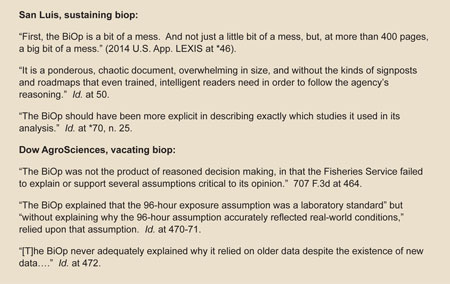ESA: Smelt v. Salmon (and Maybe v. Snail Darters)
The Importance of the San Luis Decision
Last month, the U.S. Court of Appeals for the Ninth Circuit reinstated a 2008 U.S. Fish & Wildlife Service biological opinion regarding the impact on the delta smelt, a small fish, of the U.S. Bureau of Reclamation's delivery of water from the Sacramento Delta to central and southern California. San Luis & Delta-Mendota Water Authority v. Jewell, 2014 U.S. Ap. Lexis 4781 (March 13, 2014). Despite recognizing the legitimacy of concerns with several aspects of the modeling and analysis on which the biop's “reasonable and prudent alternatives” (RPAs) were based, the Court held it was obliged to defer to the expertise of the Service. In essence, the Ninth Circuit took the opposite approach of the Fourth Circuit. Last year in Dow AgroSciences LLC v. National Marine Fisheries Service, 707 F.3d 462 (4th Cir. 2013), that Circuit vacated a National Marine Fisheries Service biop that addressed the potential impact of use of several pesticides on salmon. The difference between the two courts' views is demonstrated in the accompanying box.

But the difference between the two holdings is not academic. The delta smelt decision has far more immediate impact than Dow AgroSciences. Unless it is reversed or set aside by legislative action, in light of the ongoing California drought San Luis means that much of the enormously-fertile San Joaquin Valley and areas south will be denied the water. And unless reversal comes from an en banc reconsideration by the Ninth Circuit, the decision creates a circuit split that could result in Supreme Court attention.
That split arises from the two courts' different handling of several issues. The simplest one to present, however, is over the question of how much a consulting Service must consider the economic implications of its RPA recommendations. And addressing that difference could lead the Supreme Court to revisit two conclusions of the seminal 1978 Tennessee Valley Authority v. Hill decision, 437 U.S. 153, that have provided the underpinnings of a great deal of Endangered Species Act (ESA) precedent since.
In TVA, a 6-3 majority found that the concern for the survival of snail darters (another small fish) could block construction of the Tellico Dam. Writing through Chief Justice Burger, the Court found that “[w]hile there is no discussion in the legislative history [of the ESA] of precisely this problem, the totality of congressional action makes it abundantly clear that . . . [t]he plain intent of Congress in enacting this statute was to halt and reverse the trend toward species extinction, whatever the cost.” Id. at 184 (italics added). And the majority also found that the omission from the current version of the ESA of “the type of qualifying language previously included in endangered species legislation reveals a conscious decision by Congress to give endangered species priority over the ‘primary missions' of federal agencies.” Id. at 185 (italics added).
The Disputed Regulation
Among the arguments presented by challengers of the biops in both San Luis and Dow AgroSciences was the adequacy of the relevant Service's compliance with the Services' own, jointly promulgated, ESA-implementing regulations. That regulation, 40 C.F.R. §402.02. It defines the RPAs set forth in a biop as the way to avoid jeopardy to the relevant species as:
Alternative actions identified during formal consultation [1] that can be implemented in a manner consistent with the intended purpose of the action, [2] that can be implemented consistent with the scope of the Federal agency's legal authority and jurisdiction, [3] that is economically and technologically feasible, and [4] that the Director believes would avoid the likelihood of jeopardizing the continued existence of listed species or resulting in the destruction of adverse modification of critical habitat. (Italics added).
Both Courts of Appeal recognized, as they must have, that a biop-authoring Service is bound by its own regulations. But the Ninth Circuit saw the criteria quoted above as only part of a definition, not a mandate against which to judge each RPA. And, more importantly, it adopted the view—expressly on the basis of TVA, among other authorities—that the economic and technological feasibility criterion italicized above required consideration only of economic and technological feasibility to the action agency (here, the Bureau of Reclamation) of the proposed action, not the economic impact of the decision on others.
In contrast, the Fourth Circuit expressly refused to “read out” of the Services' mandate the need for the broader evaluation of economic and technological feasibility. 707 F.3d at 474. It expressly rejected NMFS's TVA-based argument that the need to protect species “whatever the cost” trumped evaluation of economic impacts. And it did so for a very clear, explicit reason: because the petitioning pesticide manufacturers were challenging the Service's refusal to consider the impact on farmers of a prohibition of applying their products “within 500 feet (for ground applications) and 1,000 feet (for aerial applications) of any waterway that is connected, directly or indirectly, at any time of the year, to any water body in which salmonids might be found at some point." Id. at 475. (Italics in original). In such a situation, the Fourth Circuit held, determination of the economic feasibility of a requirement is “especially relevant.”
Although the Dow AgroSciences opinion does not present additional authorities in support of its holding that the lack of economic analysis “provides another basis for our conclusion that the BiOp was arbitrary and capricious,” id. at 475, substantial support exists. Perhaps the most important is Justice Scalia's opinion for a unanimous Supreme Court in Bennett v. Spear, 520 U.S. 154 (1997). There, the Court found that “economic consequences are an explicit concern of the Act.” 520 U.S. at 177. The Supreme Court found particularly relevant the ESA's requirement that each agency ground its decision on “the best scientific and commercial data available”:
The obvious purpose of [this requirement] is to ensure that the ESA not be implemented haphazardly, on the basis of speculation or surmise. While this no doubt serves to advance the ESA's overall goal of species preservation, we think it readily apparent that another objective (if not indeed the primary one) is to avoid needless economic dislocation produced by agency officials zealously but unintelligently pursuing their environmental objectives. That economic consequences are an explicit concern of the Act is evidenced by §1536(h), which provides exemption from §1536(a)(2)'s no-jeopardy mandate where there are no reasonable and prudent alternatives to the agency action and the benefits of the agency action clearly outweigh the benefits of any alternatives. We believe the “best scientific and commercial data” provision is similarly intended, at least in part, to prevent uneconomic (because erroneous) jeopardy determinations. Petitioners' claim that they are victims of such a mistake is plainly within the zone of interests that the provision protects.
But Bennett's rejection of TVA's exalted view of the ESA's protective mandate did not just reflect a change in the make-up of the Supreme Court. In fact, the Congress itself had signaled TVA's overbreadth five months after that decision was rendered when, in direct response to that decision's observation that “there are no exemptions in the [ESA] for federal agencies,” it amended the statute to create one. And a decade later, Congress underlined its concern with the potential disruptive effect of ESA decisions on agriculture by adding to an appropriations act a provision requiring evaluation by the Secretary of Interior and of how to “minimize the impacts [of species conservation activities] to persons engaged in agricultural food and fiber commodity production” and to “allow persons to continue production of agricultural food and fiber commodities.”
Conclusion
We have heard far from the last about the San Luis decision. The time has not yet run out for a request of rehearing en banc, so it is possible the Ninth Circuit will yet have more to say about delta smelt in the next few months. But unless last month's hearing is reversed by an en banc panel, it seems very likely that the Supreme Court soon will be given another opportunity to opine about a critical aspect of the ESA. And for those whose legal positions rest heavily on the expansive language of the TVA opinion, this is not likely to be an attractive situation—especially if, by the time a further appeal of the San Luis case is heard, the water crisis in California has become even greater.
